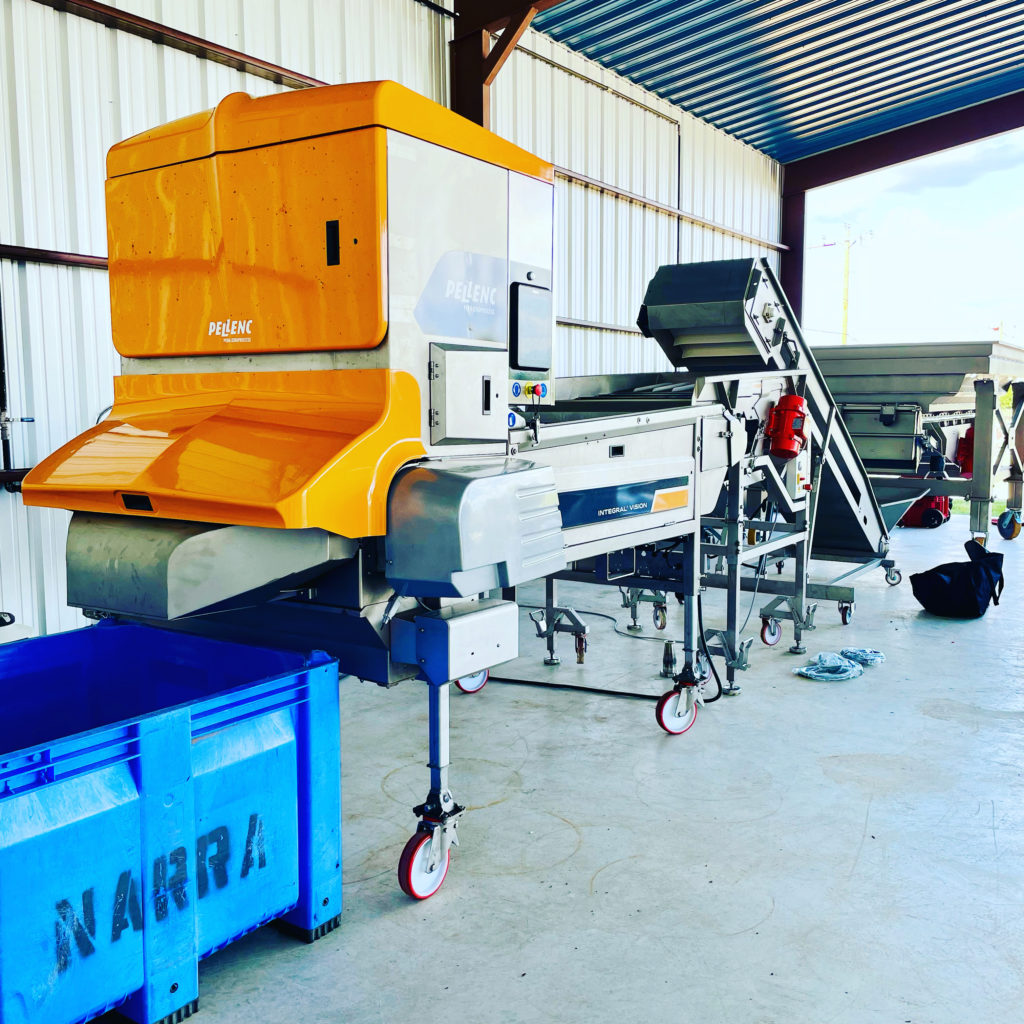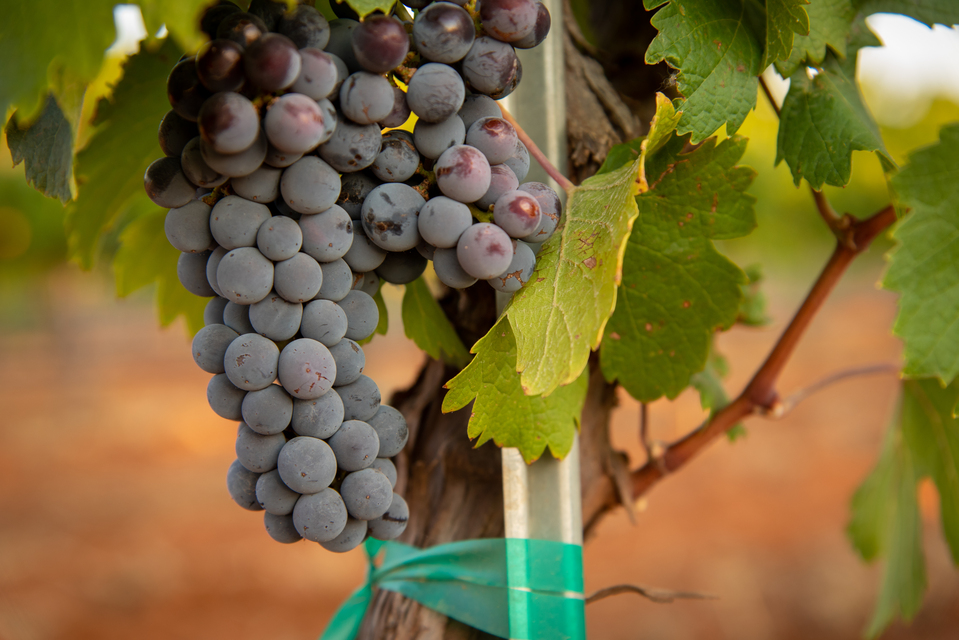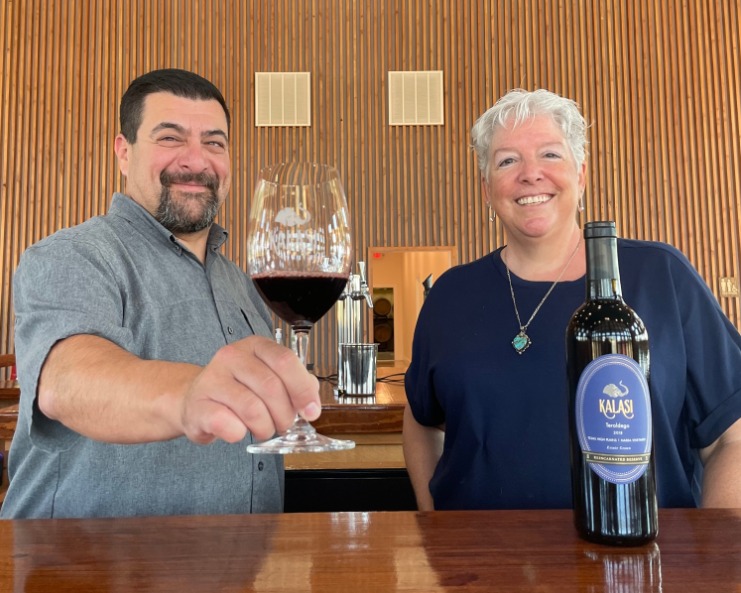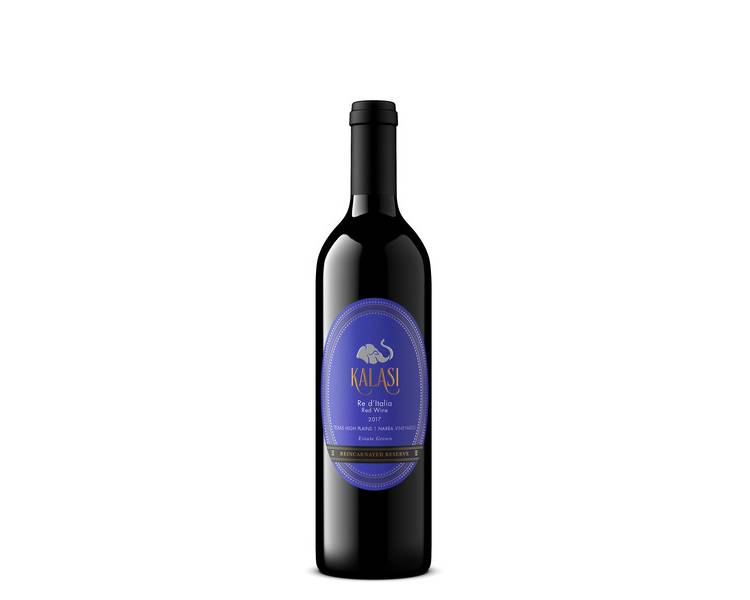August 15, 2022: Optical Sorting
Optically Sorting Wine Grapes!

If you’ve seen our social media accounts from early August 2022 (so the past week or so), I’m sure you’ve seen a video or story about our optical sorting line. As many customers aren’t fully in the weeds with winemaking techniques and tools, we imagine we need to share more information about what an optical sorter does, how it does it, and why it is important.
When we harvest grapes from our estate vineyard, we typically (as in we always use this except for a few one-off hand harvests) use a state-of-the-art mechanical harvester made by Pellenc. This machine has bands that shake the vines and cause clusters of grapes to fall down. These clusters are caught by the harvester and brought to the top of the machine where there is an onboard destemmer. This removes the grapes from the stems, and has a series of rollers that seek to sort out material other than grapes (MOG) and berries that are not the correct size. This destemmer and mechanical sorting table do an excellent job, but at the end of the day they are limited in what they can do. This means there are still things like green berries, MOG, etc. in our harvest bins. If we don’t do any additional sorting, this material is incorporated into our fermentation and impacts the flavor of the wine we produce.
So here’s where the optical sorting line comes in. There are multiple components to the optical sorting line, but we’ll start with the final piece – the actual optical sorter. The optical sorter consists of a few main components. First, there is a blue belt that moves VERY quickly. Second, there is a tower that contains lights and a camera. Third, there is a line with jets of compressed air.
The blue belt has grooves – these grooves are aligned with the compressed air jets in the optical sorter. As fruit moves along the blue belt, the bright lights in the tower shine down on the belt and the camera scans all material on the belt. Based on settings we, the winemakers, input, we can tell the machine what grape color, size, shape, etc. we want to keep, and what we want to remove. As the blue belt moves very quickly, everything on it flies off the end. As the material is mid air, the computer uses data from the camera and winemaker’s input to determine which air jets to use to shoot down any less desirable material. This unwanted material is shot down into an auger that collects all items into a bucket. The good grapes continue their path flying forward and land in our blue harvest bins.
Now, prior to our optical sorter, there are three other pieces of equipment. If you check out setups at other wineries, you may see different configurations that include destemmers, but that piece of equipment is on our harvester, so it is not needed in our setup. The first piece of equipment in our line is a receiving hopper. This is a massive stainless steel tub. We rotate bins of freshly picked grapes into it, and then any juice is strained off (trucking can crush some grapes, hence the juice). Then this hopper vibrates to nudge grapes towards its exit door. We control this exit door with hydraulics so that we only have a handful of grapes exiting at a time. When the grapes exit the hopper, they are loaded onto an elevator.
Grape elevators are not what most people are accustomed to when they hear the word “elevator”. It’s more like an escalator with a belt that scoops up grapes and brings them diagonally. At the top of the elevator, the grapes fall onto a vibrating table.
This vibrating table drains any additional juice off the grapes and then has slots that allow small material, like seeds, to fall out of the way. The other purpose of this table is to spread the grapes into a single layer (no stacked grapes) so that they are ready to be loaded onto the optical sorter. At the end of the vibrating table, grapes fall onto the blue belt of the optical sorter. This is where the real magic happens that I previously described.
So you may be wondering why this is all needed. Since we are dead set on making the best wine that has ever been made in Texas, we need the very best starting product. We grow all our own grapes to help achieve that, but we still need to ensure that we’re not having any “bad apples” ruin the bunch. Optical sorting lines like ours are used at many, if not most, of the best wineries in the world. It is a critical piece of technology for processing fruit, and we are the first winery to bring it to Texas.
Now, why can’t we just have a lineup of staff or volunteers picking out any less desirable material. The answer is theoretically you can…but realistically you can’t. Our optical sorting line can process 12 tons of fruit per hour. We’re a small winery (but with big aspirations) so we’re not typically maxing out the line’s throughput yet but we can still process FAR more fruit that we could by hand, and we can run most of our picks in an hour even accounting for some inefficiencies on our end (having one forklift, loading fruit into bins rather than tanks for fermentation, etc.). The amount of labor it would take to process even 3 tons by hand would be brutal and not many people would stick around for all of our harvest if all they were doing was looking at millions of grapes. Additionally, the optical sorter is 97% effective at picking out the less desirable material. The computer can size up a grape and know if it’s below our threshold far more easily than a person could.
At the end of the day, this equipment gives us the most control over what makes it into every wine we make and at a speed that makes it possible to use across all wiens we make. When we combine this technology with all our efforts in the vineyard to grow the best possible grapes and with our small batch, high quality focus in the winery, we believe we will have amazing breakthroughs on the resulting wine quality. We are ecstatic to share this innovation with all our customers, so be on the lookout for optically sorted wines to hit the market in 2023, such as our 2023 Sagrantino (the first optically sorted wine in Texas).
See our Pellenc Vision 3 Optical Sorter in Action with 0.55 ton/acre Sagrantino!


